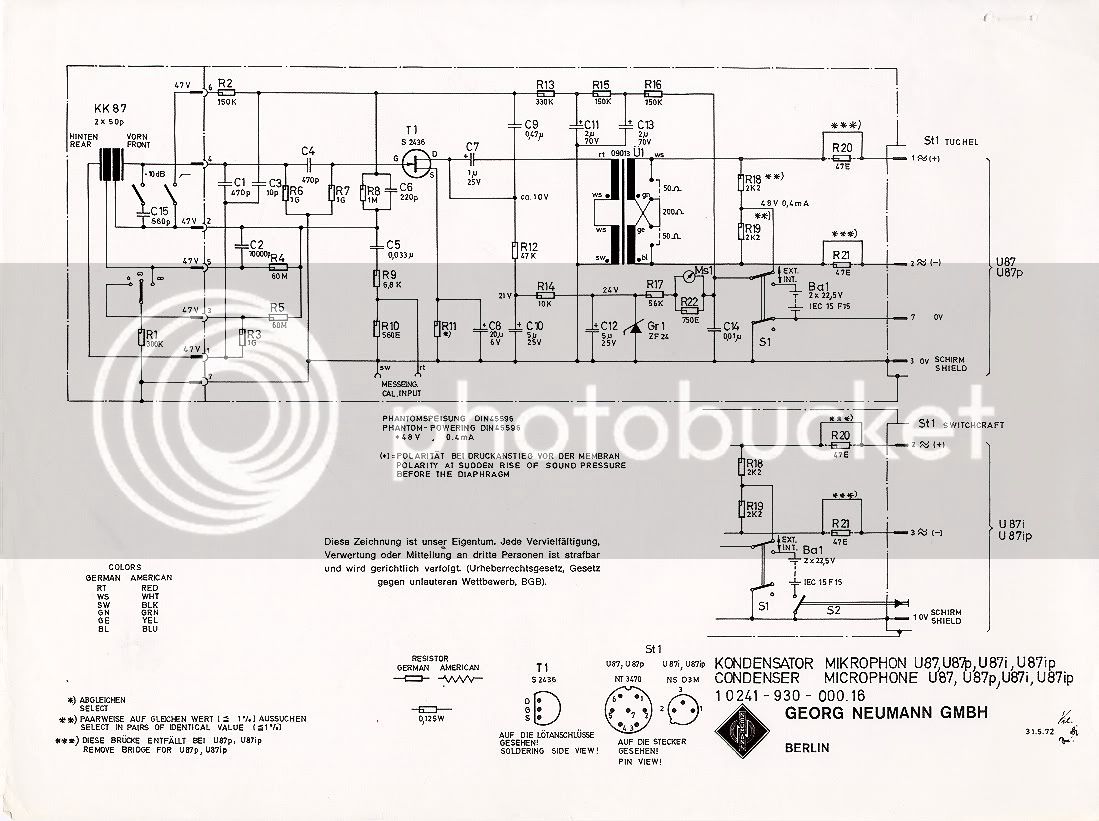Silvas
Well-known member
Hello,
I´m learning a bit about this microphone, as i´m finishing reviving a very mistreated one, from early 70´s, and i paid almost nothing for it. For money reasons, i chose to reskin the capsule over a new original capsule (too much $$$ right now). After many hours troubleshooting, finally it´s working as i´ts supposed to, and begging to be modded...i´m not keeping the mic for collecting reasons but i want to use it everyday as a tool and don´t mind modding it rather than trying to keep it completely original.

I´m putting new BC264 FET on it, and for now, i´m leaving a trimmer for biasing it, which i´ll replace with an adequate resistor later. I replaced the coupling cap, but i´m looking for the nicest film cap i can put in the mic. I also removed the 220pF cap in paralell with the 1m resistor, which, iirc, disconnects the HF attenuation of the mic amp, and i actually like the 87 without it. A couple of the studio´s 87´s are modded this way (i think this mod was done by someone on gotham audio many years ago) and i like how they sound, specially for distant miking.
What i´m trying to understand is how the negative feedback works on this circuit. I would love to hear the mic with all the NFB removed, as some people say NFB in this mic adds some honkiness to the sound.
Could some mic experts here help me understand NFB on the 87 ?
Also, i´m wondering if it´s a good idea to replace both 470pF caps between capsule and FET with nicer ones, what do you think? maybe a bit of experimentation with the values here ?
Thanks so much !
I´m learning a bit about this microphone, as i´m finishing reviving a very mistreated one, from early 70´s, and i paid almost nothing for it. For money reasons, i chose to reskin the capsule over a new original capsule (too much $$$ right now). After many hours troubleshooting, finally it´s working as i´ts supposed to, and begging to be modded...i´m not keeping the mic for collecting reasons but i want to use it everyday as a tool and don´t mind modding it rather than trying to keep it completely original.

I´m putting new BC264 FET on it, and for now, i´m leaving a trimmer for biasing it, which i´ll replace with an adequate resistor later. I replaced the coupling cap, but i´m looking for the nicest film cap i can put in the mic. I also removed the 220pF cap in paralell with the 1m resistor, which, iirc, disconnects the HF attenuation of the mic amp, and i actually like the 87 without it. A couple of the studio´s 87´s are modded this way (i think this mod was done by someone on gotham audio many years ago) and i like how they sound, specially for distant miking.
What i´m trying to understand is how the negative feedback works on this circuit. I would love to hear the mic with all the NFB removed, as some people say NFB in this mic adds some honkiness to the sound.
Could some mic experts here help me understand NFB on the 87 ?
Also, i´m wondering if it´s a good idea to replace both 470pF caps between capsule and FET with nicer ones, what do you think? maybe a bit of experimentation with the values here ?
Thanks so much !


